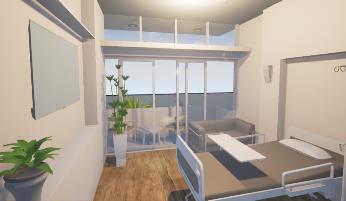View-out and Dementia in Elderly
Main Article Content
Abstract
A study was aimed to explore the effect of view-out on dementia in Thai elderly in hospital. There were two types of view-out to be investigated their effects. The first type was no window/view-out and the second was a natural view. The study was explored in both single ward and shared word in hospital. The experiment was carried out in a laboratory room in Faculty of Architecture, Kasetsart University, using Virtual Reality (VR) technique. Subjects evaluated VR environment using dementia measurement, which were wayfinding questionnaire. Then, data of this study was analysed using a Paired t-test. The results suggested that both single room and shared room in hospital with natural view could create better wayfinding performance of Thai elderly than those without.
Article Details

This work is licensed under a Creative Commons Attribution-NonCommercial-NoDerivatives 4.0 International License.
References
กระทรวงสาธารณะสุข. (2554). ความรู้และการดูแลผู้ป่วยโรคสมองเสื่อมสำหรับญาติและผู้ดูแล. ชลบุรี: ศูนย์สมเด็จพระสังฆราชเพื่อผู้สูงอายุ.
Arthur, J.E., Hancock, P. & Chrysler, S. (1997). The perception of spatial layout in real and virtual worlds. Ergonomics. 40, 69-77.
Boyce, P.R. (2009). “The impact of light in building on human health”. International Conference on Sustainable Healthy Buildings. 2nd. Korea.
Hanford, N and Figueiro, M. (2013). Light Therapy and Alzheimer’s Disease and Related Dementia: Past, Present and Future. J Alzheimers Dis., 33(4), 913-922.
Hidayetoglu, L.M., Yildirim, K. & Akalin, A. (2012). The effects of color and light on indoor wayfinding and the evaluation of the perceived environment. Journal of Environmental Psychology , 32, 50-58.
Netten, A. (1989). The effect of design of residential homes in creating dependency among confused elderly residents: A study of elderly demented residents and their ability to find their way around homes for the elderly. International Journal of Geriatric Psychiatry.
Noell-Waggoner, E. (2002). Light: an essential intervention for Alzheimer’s disease. Alzheimer’s Care Quarterly , 3(4), 343–352.
Ulrich, R. S. (1984). View through a window may influence recovery from surgery. Science, 224(47), 420 – 421.
Wohlwill, J. F & Altman, I. (1983).H uman Behavior and Environment .A dvances in Theory and Research (Volume 2). New York: Plenum New York.

